Native Grasses
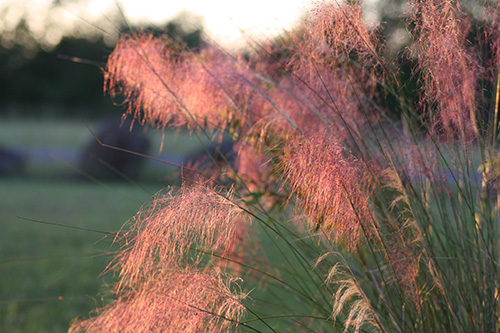
The sound of grass rustling in the breeze can put anyone at ease. Florida’s native ornamental grasses not only work well in our climate, they’re also an excellent option for filling up large areas with vegetation. Most species require little maintenance, and some tolerate flooding or provide ecosystem services such as erosion control. Below is a list of select grasses native to Florida that can add both charm and volume to your landscape.
Muhly Grass
Muhly grass (Muhlenbergia capillaris) is an ornamental grass native to Florida with stiff, slender, upright foliage. The plant is tolerant of Florida’s temperature ranges and can be planted year-round in USDA Hardiness Zones 7 to 11. This low-maintenance plant produces clumps that can reach up to 3 to 5 feet tall and spread 2 to 3 feet wide. The leaf color is green but may have light brown portions late in the season. In the fall, fluffy pink to purple blooms develop. The small inconspicuous fruits are brown and oval with a hard, dry exterior. Muhly grass thrives in full sun and can handle both drought and flooding. Its durability during flooding makes it an excellent choice for beach-front properties or wetland sites. For an impressive statement, muhly grass can be planted in large groups on the landscape.
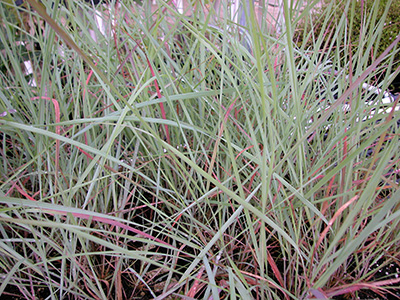
Elliot’s Lovegrass
Elliot’s lovegrass (Eragrostis elliottii) is one of the smaller native grass species, reaching only 1 to 3 feet in height. The grass is commonly seen growing wild in flatwoods, sandhills, and prairies, but also does well in the home landscape as a border or accent plant. It acts as a perennial in hardiness zones 8A to 11, coming back each year. The plant forms tufted clumps with stiff, curving leaves. Tan or gray wispy flowers bloom between October and November, providing a subtle salute to the fall season. The grass prefers dry, hot conditions in full sun, although it can handle partial shade. It does not require much irrigation (even during droughts); you only need to water Elliot’s lovegrass the first couple of weeks after planting until it is established. This grass is useful on steep slopes for erosion control, serving as an excellent plant for maintaining the stability of your landscape.
River Oats
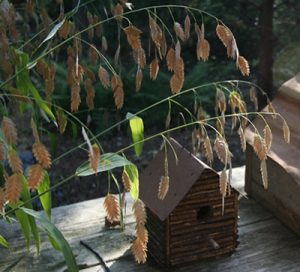
River oats (Chasmanthium latifolium), also known as inland sea oats or wild oats, are native to 28 states, including Florida. They have broad leaves that taper to a sharp point. River oats have flattened, oat-shaped seedheads that change from green to golden in the fall and are often persistent into winter. The foliage can reach up to 3 feet tall with an arching, bamboo-like quality. River oats grow along stream banks in the wild, preferring moist soil in partial shade. The plant can serve as a border and would be an excellent addition to a rain garden. River oats help control erosion and work well on slopes, but they spread readily so be sure to use a barrier such as landscape edging. They do best in northern Florida (hardiness zones 3 to 9) and should be cut back in early spring for optimal growth.
Sand Cordgrass
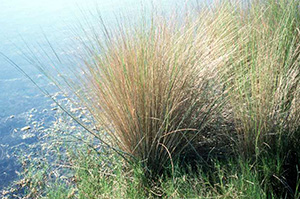
Sand cordgrass (Spartina bakeri), also called marsh grass, is a native ornamental grass that sports fine-textured, wiry leaves resembling the spray of a fountain. The plant produces brown flowers in the spring, which are not very abundant or visible. It grows in hardiness zones 8B through 11 and can be planted year-round. Sand cordgrass can serve as a border or accent plant and can produce a dramatic effect when planted in mass. It can reach 3 to 4 feet in height and spread to a width of 3 to 5 feet. The green foliage turns brown or tan in the fall. The plant prefers full sun and has a high drought tolerance—perfect for Florida’s climate. It’s also tolerant of wet soil and is ideal for bordering ponds and streams, adding a serene waterscape view.
Sea Oats
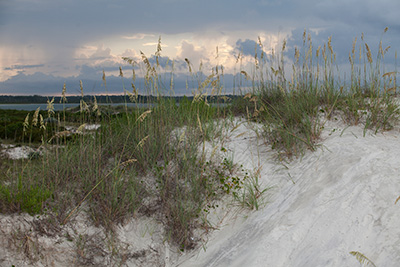
Sea oats (Uniola paniculata) are a perennial ornamental grass that populate beaches throughout Florida, helping to build dunes by trapping sand. Their ability to prevent erosion during storms and deter the impact of wind and waves makes it a necessity in coastal areas. They thrive in hardiness zones 7B through 11 year-round in full sun. Sea oats can grow quite tall, reaching heights of 5 to 8 feet, with a spread of 1 to 2 feet. The leaf blade is green, and flowers appear as small white blooms in the summer and fall. The fruit is brown and oval-shaped with a hard exterior. Since sea oats are an important asset to the community, it is illegal to cut, harvest, remove, or eradicate them in the wild without proper permitting. Sea oats’ high tolerance for salt and drought makes it an ideal plant for Florida homes near coastal areas, but it can be planted in yards throughout the state.
Fakahatchee Grass
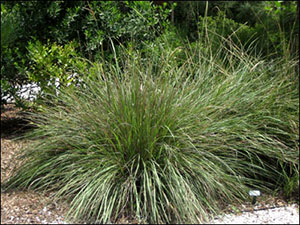
Fakahatchee grass (Tripsacum dactyloides) is an easy-to-grow native that forms tall clumps 4 to 6 feet tall and wide. While it makes an excellent accent or border plant, you’ll want to avoid wading through the foliage—its thin, grass-like leaves have small, sharp teeth along the edges. But lucky for you, pruning is not required, so getting close and personal with the plant can be avoided. The grass produces flowers in late spring that are white, pink, yellow, or rust colored. Fakahatchee grass grows in hardiness zones 8 to 11. It prefers full sun but can also succeed in partial shade. It is naturally found in sites such as riverbanks, hammocks, and swamps, and shows a preference for wet or irrigated sites in the home landscape. Fakahatchee grass is moderately drought tolerant and can withstand flooding, making it a resilient species. There is also a dwarf Fakahatchee grass—sometimes called Tripsacum floridanum—that only reaches two to three feet.
